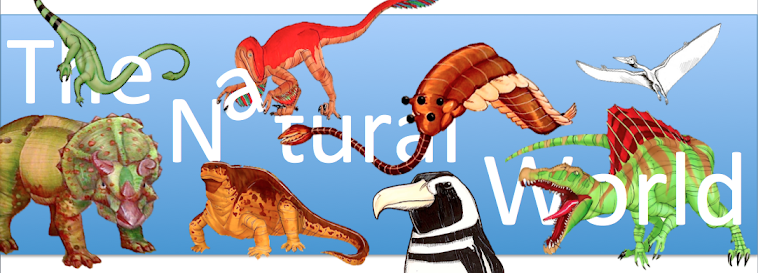Interestingly, paleontologists today are using the Australian Aborigines to help them figure out when Australia's Pleistocene megafauna went extinct. While today, there are no native animals larger than the red kangaroo, Pleistocene Australia was a very different place, as was the rest of the world. The Pleistocene Epoch was the time of the Ice Age megafauna. With the exception of Africa and south-east Asia, in most places nowadays, the Pleistocene megafauna is extinct, but back then, the megafauna were a world-wide phenomenon. In Eurasia, there were the giant mammoths and rhinoceroses, the cave lions and hyenas, the Irish elk, and the giant polar bear. In North America, there were the mammoths and mastodons, the short-faced bear, the giant bison, the dire wolf, the giant beavers, and the saber-toothed cats. In South America, there were the giant ground sloths, the armored glyptodonts, and many large relatives of elephants.
Australia also had its fair share of Pleistocene megafauna, with marsupial lions, the giant short-faced kangaroos, the hippo-sized wombat Diprotodon, and echidnas that were the size of sheep. There are two main hypothesis when it comes to what caused the extinction of all these animals: climate change, or hunting by early human arrivals on Australia, the first Aborigines. No one could figure out whether it really was the Aborigines that had hunted the megafauna to extinction, though, because no one could figure out the date that the megafauna had gone extinct, nor could they figure out the date that humans first arrived on Australia. Some people believed that the megafauna survived until around 6,000 years ago, while others believed that they went extinct a great many years prior. The same difficulties confronted those scientists attempting to determine when humans first arrived. The sediments of Australia are notoriously hard to date, and since the animals of Australia are so unique (especially following the extinction of the dinosaurs), scientists were unable to correlate their data with other places around the world.[1]
As more scientific discoveries were made, a new method of dating rocks was discovered, called optically stimulated luminescence (or OSL for short). Using OSL, paleontologists were successfully able to date many different specimens of the various marsupial Pleistocene megafauna, and found that, while many of them approached the 46,000 years ago mark, none of them passed it. Many different specimens were used from all across Australia, but they all said the same thing: 46 was the answer.
Meanwhile, with the new OSL tool in their bag, other scientists headed off to sites of known human habitation to attempt to date them as well, and these efforts proved to be successful. One of the main places that they dated was a place known as Devil’s Lair, a known area of ancient Aboriginal inhabitance. What was especially important about Devil’s Lair was that there was sediment present for the last 63,000 years, meaning that instead of just a snapshot of time, the scientists had an uninterrupted sequence of time to figure out when humans started living there. As the scientists dated the sediments with the first signs of human inhabitance, they came up with the magic number: 46,000. Other sites came up with the same number too, including Lake Mungo, the oldest human burial known from Australia. At Lake Mungo, the dates were a bit less precise, ranging from between 45,000 and 47,000 years ago, but the data still seems to point in the same direction. The ancestral Aborigines arrived on the continent at around the same time that Australia’s Pleistocene megafauna went extinct. With this new dating technique, scientists were also able to determine that there was no significant climate change for many thousands of years on either side of the 46,000 mark, effectively ruling out that hypothesis. So it seems that, for a time, the people who believe themselves as part of the land and the natural world around them actually destroyed a significant part of it.
[1] For
example, paleontologists studying dinosaurs of the Late Jurassic Morrison Formation here in Colorado are able to look at closely related dinosaurs in
other parts of the world like the UK and southern Africa (keep in mind that the
continents were all together in one big landmass back then.) That way, if the paleontologists are unable
to determine the dates of, say, the Tendaguru Formation in Tanzania, they can
look to the studies done on the rocks of the Morrison Formation for an accurate
estimation. This is a luxury that
paleontologists, archaeologists and other scientists working in Australia
simply do not have.


No comments:
Post a Comment